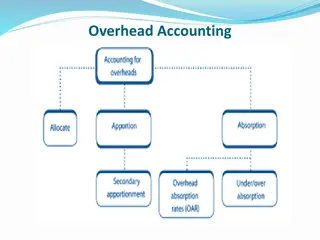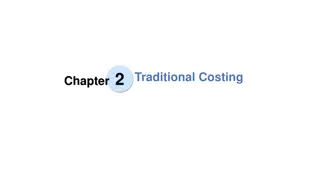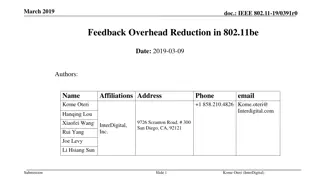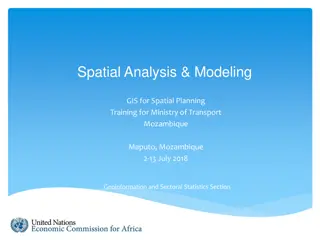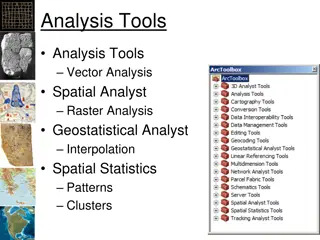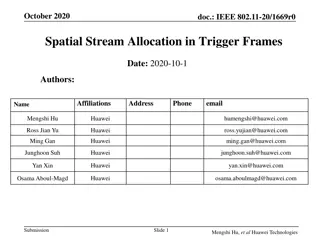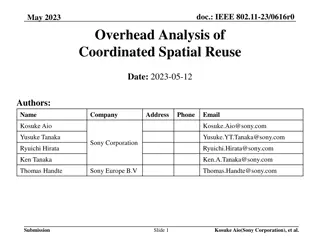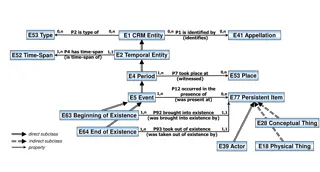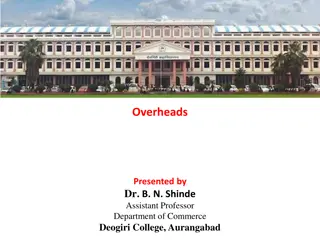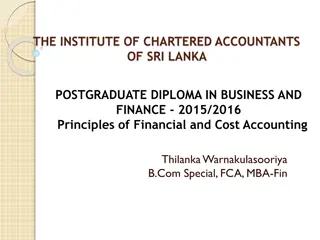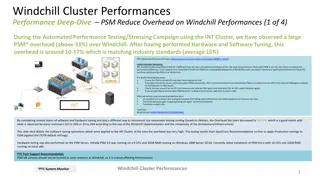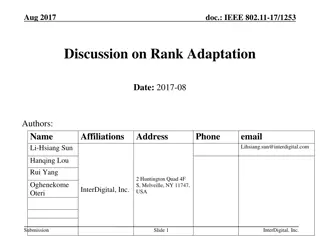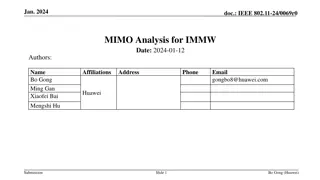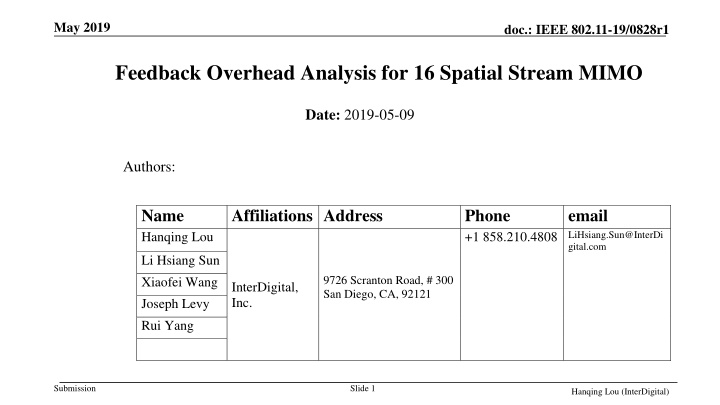
Overhead Analysis for 16 Spatial Stream MIMO in IEEE 802.11
"Explore the feedback overhead analysis for implementing 16 spatial streams using 802.11 protocols, focusing on reducing overhead for efficient channel acquisition and multi-AP coordination. Delve into the challenges and improvements in sounding/feedback mechanisms for enhanced performance. Stay informed on the latest advancements in wireless communication standards."
Download Presentation

Please find below an Image/Link to download the presentation.
The content on the website is provided AS IS for your information and personal use only. It may not be sold, licensed, or shared on other websites without obtaining consent from the author. If you encounter any issues during the download, it is possible that the publisher has removed the file from their server.
You are allowed to download the files provided on this website for personal or commercial use, subject to the condition that they are used lawfully. All files are the property of their respective owners.
The content on the website is provided AS IS for your information and personal use only. It may not be sold, licensed, or shared on other websites without obtaining consent from the author.
E N D
Presentation Transcript
May 2019 doc.: IEEE 802.11-19/0828r1 Feedback Overhead Analysis for 16 Spatial Stream MIMO Date: 2019-05-09 Authors: Name Hanqing Lou Affiliations Address Phone +1 858.210.4808 LiHsiang.Sun@InterDi email gital.com Li Hsiang Sun Xiaofei Wang Joseph Levy Rui Yang 9726 Scranton Road, # 300 San Diego, CA, 92121 InterDigital, Inc. Submission Slide 1 Hanqing Lou (InterDigital)
May 2019 doc.: IEEE 802.11-19/0828r1 Abstract In this contribution, we provide an overhead analysis for sounding/feedback for 16 spatial streams using 802.11ax protocols and discuss the need for feedback overhead reduction for 16 Spatial Stream MIMO and Multi-AP coordination in 802.11be. Submission Slide 2 Hanqing Lou (InterDigital)
May 2019 doc.: IEEE 802.11-19/0828r1 Introduction 16 spatial stream MIMO has been discussed as a possible feature for 802.11be [1]. Preliminary simulation results show performance benefits in increasing the number of spatial streams [2]. However, this comes with an attendant increase of the required sounding and feedback. In 802.11ax sounding and feedback were modified to support the new numerology and OFDMA transmissions [9], compared to the TDM based feedback in VHT . Reduction of the overhead required for efficient channel acquisition at the transmitter for 16 Spatial Stream MIMO and Multi-AP coordination in 802.11be were discussed in [3]. Questions were raised regarding if the sounding and feedback mechanisms defined in 802.11ax were adequate to support 16 spatial stream. In this contribution, we provide an overhead analysis of 16 SS training using 802.11ax sounding/feedback. Submission Slide 3 Hanqing Lou (InterDigital)
May 2019 doc.: IEEE 802.11-19/0828r1 Sounding and Feedback in 802.11ax (1/2) One-to-multiple sounding feedback is supported in 802.11ax. This enables multiple STAs to provide feedback at the same time and reduce the overhead relative to one-by-one sounding, as in 802.11ac. [9] Submission Slide 4 Hanqing Lou (InterDigital)
May 2019 doc.: IEEE 802.11-19/0828r1 Sounding and Feedback in 802.11ax (2/2) Feedback Segmentation: If HE compressed BF/CQI frame exceeds 11454 bytes, the report should be split into up to 8 feedback segments. All feedback segments shall be sent in a single A-MPDU contained in a PPDU and shall be included in the A-MPDU in the descending order of the Remaining Feedback Segments subfield values. [9] The length of feedback report is limited by the Length field in the L-SIG field (L_LENGTH). Length field has 12 bits, which can cover up to 4095 bytes Length is calculated from TXTIME using 6Mbps rate in legacy mode. TXOP signaled in HE SIG-A is up to 8448us. Though this duration of 844us is not the actual limit of TXOP, it serves as a good indication that a sounding sequence greater than this duration is not practical. Submission Slide 5 Hanqing Lou (InterDigital)
May 2019 doc.: IEEE 802.11-19/0828r1 Feedback Overhead Analysis for 16 SS (L_LENGTH constraint) The analysis is to evaluate: Are sounding and feedback defined in 802.11ax enough to support 16 spatial stream training? Analysis method: Evaluate the size of HE compressed beamforming report, that is carried in an HE TB PPDU. L_LENGTH is used as overhead measure. Settings in NDPA: Feedback type: [SU, MU]. Ng: [4, 16]. Quantize resolution ?,? : [(4,2) or (6,4)] for SU; [(7,5) or (9,7)] for MU # of RUs to be measured: [4, 9] HE TB PPDU setting: MCS4, nominal PE (8us), 2xHE-LTF + 1.6us GI, Nss=1. RU size to carry HE compressed BF report: [26-tone, 52-tone, 106-tone, 242-tone]. Submission Slide 6 Hanqing Lou (InterDigital)
May 2019 doc.: IEEE 802.11-19/0828r1 SU-MIMO: 16 SS Cases, BW=20MHz 11ax can t support: feedback with L_LENGTH greater than 4095 Bytes SU report # 26-tone RUs 9 9 4 9 9 9 4 9 9 fdbk_R U 26 26 26 26 52 26 26 26 52 report AMPDU size (bytes) 4364 4504 3500 7448 7448 5856 4556 9696 9696 Nr 16 16 16 16 16 16 16 16 16 Nc 4 8 8 8 8 16 16 16 16 Ng 4 4 4 4 4 4 4 4 4 phi 6 4 6 6 6 4 6 6 6 txop (us) 7626.4 7846.4 6244 12559.2 6533.6 10010.4 7928.8 16155.2 8333.6 report L_LENGTH 5266 5431 4228 8965 4495 7054 5494 11662 5845 Nr x Nc is the V matrix size. TXOP duration = NDPA + NDP + BFRP + Feedback + 3SIFS Trade off for Feedback RU size and TXOP for training: To support the same number of concurrent STA sounding/feedback, the larger RU size allocated for each STA, the smaller the number of concurrent STAs supported for each BFRP, and thus the longer the TXOP duration for the sounding and training procedure. Slide 7 Submission Hanqing Lou (InterDigital)
May 2019 doc.: IEEE 802.11-19/0828r1 MU-MIMO: 16 SS Cases, BW=20MHz Current 11ax mechanism can t support: feedback with L_LENGTH greater than 4095 Bytes MU report Nt Nr Ng phi Rus fdbk_RU txop (us) 8 8 4 9 9 26 6735.2 16 16 4 7 4 26 9757.6 16 16 4 7 9 26 20047.2 16 16 4 7 9 52 10277.6 16 16 4 9 2 26 7476 16 16 4 9 4 26 12637.6 16 16 4 9 4 52 6572.8 16 16 4 9 9 26 26188 16 16 4 9 9 52 13351.2 16 16 4 9 9 106 6559.2 16 16 16 9 9 26 8667.2 16 8 4 7 4 26 7533.6 16 8 4 7 9 26 15258.4 16 8 4 7 9 52 7883.2 16 8 4 9 4 26 9743.2 16 8 4 9 9 26 20032.8 16 8 4 9 9 52 10269.6 16 8 16 9 9 26 6733.6 16 4 4 7 9 26 9210.4 16 4 4 9 9 26 11975.2 16 4 4 9 9 52 6241.6 16 2 4 9 9 26 6752 # 26-tone report AMPDU size (bytes) 3888 5696 12128 12128 4272 7496 7496 15968 15968 15968 5016 4308 9136 9136 5688 12120 12120 3808 5356 7084 7084 3820 report L_LENGTH 4693 6865 14581 7303 5152 9025 4525 19186 9607 4534 6046 5197 10990 5506 6853 14572 7297 4597 6454 8527 4276 4609 Nr x Nc is the V matrix size. TXOP duration = NDPA + NDP + BFRP + Feedback + 3SIFS Submission Slide 8 Hanqing Lou (InterDigital)
May 2019 doc.: IEEE 802.11-19/0828r1 Analysis with TXOP+L_LENGTH constraint The following slides calculate different tuples of (# of reporting STAs, feedback RU size) in a sounding sequence, and determine whether each tuple satisfies L_LENGTH limit and HE-SIG-A TXOP limit, with the assumptions: 80MHz MU NDP sounding ?,? ={9,7}, Ng=4 Report TB-PPDU (MCS=4, Nss=1) or (MCS=6, Nss=2) BFRP MCS0 Nr=16, Nc=1/2/4 Feedback RU size: 52/106/242 tones Number of non-AP STAs in a NDP sounding sequence: 4/8/16/32/64 Multiple BFRPs are used in a TXOP if the # of feedback RUs < the # of STAs participating in the sounding No error in HE compressed BF/CQI frame (best case) Submission Slide 9 Hanqing Lou (InterDigital)
May 2019 doc.: IEEE 802.11-19/0828r1 BW=80MHz, Nr=16, Nc=1, fdbk MCS=4,nss=1 (<=L_LENGTH limit,<=Txop limit ) # of fdbk STAs fdbk RU size 4 8 16 32 64 52 (FALSE, TRUE) (FALSE, FALSE) (FALSE, FALSE) 106 (TRUE, TRUE) (TRUE, TRUE) (TRUE, FALSE) (TRUE, FALSE) 242 (TRUE, TRUE) (TRUE, TRUE) (TRUE, TRUE) (TRUE, FALSE) (TRUE, FALSE) 30000 7000 6000 25000 5000 TXOP in NDP SIG-A (us) 20000 fdbk RU size - 52 4000 fdbk RU size - 106 15000 us fdbk RU size - 242 fdbk PPDU length (us) 3000 HE SIG_A txop limit - 52 L_LENGTH limit (us) 10000 HE SIG_A txop limit - 106 2000 HE SIG_A txop limit - 242 5000 1000 0 0 4 8 16 32 64 52 106 242 # of fdbk STAs fdbk RU size Submission Slide 10 Hanqing Lou (InterDigital)
May 2019 doc.: IEEE 802.11-19/0828r1 BW=80MHz, Nr=16, Nc=2, fdbk MCS=4,nss=1 (<=L_LENGTH limit,<=Txop limit ) # of fdbk STAs fdbk RU size 4 8 16 32 64 52 (FALSE, FALSE) (FALSE, FALSE) (FALSE, FALSE) 106 (FALSE, TRUE) (FALSE, FALSE) (FALSE, FALSE) (FALSE, FALSE) 242 (TRUE, TRUE) (TRUE, TRUE) (TRUE, FALSE) (TRUE, FALSE) (TRUE, FALSE) 60000 14000 12000 50000 10000 TXOP in NDP SIG-A (us) 40000 fdbk RU size - 52 8000 fdbk RU size - 106 30000 us fdbk RU size - 242 fdbk PPDU length (us) 6000 HE SIG_A txop limit - 52 L_LENGTH limit (us) 20000 4000 HE SIG_A txop limit - 106 HE SIG_A txop limit - 242 10000 2000 0 0 4 8 16 32 64 52 106 242 # of fdbk STAs fdbk RU size Submission Slide 11 Hanqing Lou (InterDigital)
May 2019 doc.: IEEE 802.11-19/0828r1 BW=80MHz, Nr=16, Nc=4, fdbk MCS=4,nss=1 (<=L_LENGTH limit,<=Txop limit ) # of fdbk STAs fdbk RU size 4 8 16 32 64 52 (FALSE, FALSE) (FALSE, FALSE) (FALSE, FALSE) 106 (FALSE, FALSE) (FALSE, FALSE) (FALSE, FALSE) (FALSE, FALSE) 242 (TRUE, TRUE) (TRUE, FALSE) (TRUE, FALSE) (TRUE, FALSE) (TRUE, FALSE) 100000 25000 90000 80000 20000 70000 TXOP in NDP SIG-A (us) fdbk RU size - 52 60000 15000 fdbk RU size - 106 50000 us fdbk RU size - 242 fdbk PPDU length (us) 40000 10000 HE SIG_A txop limit - 52 L_LENGTH limit (us) 30000 HE SIG_A txop limit - 106 20000 5000 HE SIG_A txop limit - 242 10000 0 0 4 8 16 32 64 52 106 242 # of fdbk STAs fdbk RU size Submission Slide 12 Hanqing Lou (InterDigital)
May 2019 doc.: IEEE 802.11-19/0828r1 BW=80MHz, Nr=16, Nc=1, fdbk MCS=6,nss=2 (<=L_LENGTH limit,<=Txop limit ) # of fdbk STAs fdbk RU size 4 8 16 32 64 52 (TRUE, TRUE) (TRUE, TRUE) (TRUE, FALSE) 106 (TRUE, TRUE) (TRUE, TRUE) (TRUE, TRUE) (TRUE, FALSE) 242 (TRUE, TRUE) (TRUE, TRUE) (TRUE, TRUE) (TRUE, TRUE) (TRUE, FALSE) 12000 TXOP in NDP SIG-A (us) 6000 10000 5000 8000 52 - fdbk RU size 4000 106 - fdbk RU size 6000 242 - fdbk RU size us 3000 fdbk PPDU length (us) 4000 52 - HE SIG-A txop limit L_LENGTH_limit (us) 2000 106 - HE SIG-A txop limit 2000 1000 242 - HE SIG-A txop limit 0 0 4 8 16 32 64 52 106 242 # of fdbk STAs fdbk RU size Submission Slide 13 Hanqing Lou (InterDigital)
May 2019 doc.: IEEE 802.11-19/0828r1 BW=80MHz, Nr=16, Nc=2, fdbk MCS=6,nss=2 (<=L_LENGTH limit,<=Txop limit ) # of fdbk STAs fdbk RU size 4 8 16 32 64 52 (TRUE, TRUE) (TRUE, FALSE) (TRUE, FALSE) 106 (TRUE, TRUE) (TRUE, TRUE) (TRUE, TRUE) (TRUE, FALSE) 242 (TRUE, TRUE) (TRUE, TRUE) (TRUE, TRUE) (TRUE, TRUE) (TRUE, FALSE) 18000 TXOP in NDP SIG-A (us) 16000 6000 14000 5000 12000 52 - fdbk RU size 4000 10000 106 - fdbk RU size 8000 242 - fdbk RU size us 3000 fdbk PPDU length (us) 6000 52 - HE SIG-A txop limit L_LENGTH_limit (us) 2000 4000 106 - HE SIG-A txop limit 1000 2000 242 - HE SIG-A txop limit 0 0 4 8 16 32 64 52 106 242 # of fdbk STAs fdbk RU size Submission Slide 14 Hanqing Lou (InterDigital)
May 2019 doc.: IEEE 802.11-19/0828r1 BW=80MHz, Nr=16, Nc=4, fdbk MCS=6,nss=2 (<=L_LENGTH limit,<=Txop limit ) # of fdbk STAs fdbk RU size 4 8 16 32 64 52 (FALSE, TRUE) (FALSE, FALSE) (FALSE, FALSE) 106 (TRUE, TRUE) (TRUE, TRUE) (TRUE, FALSE) (TRUE, FALSE) 242 (TRUE, TRUE) (TRUE, TRUE) (TRUE, TRUE) (TRUE, FALSE) (TRUE, FALSE) 35000 TXOP in NDP SIG-A (us) 30000 8000 25000 7000 52 - fdbk RU size 6000 20000 106 - fdbk RU size 5000 242 - fdbk RU size 15000 us 4000 52 - HE SIG-A txop limit fdbk PPDU length (us) 10000 3000 L_LENGTH_limit (us) 106 - HE SIG-A txop limit 2000 5000 242 - HE SIG-A txop limit 1000 0 0 4 8 16 32 64 52 106 242 # of fdbk STAs fdbk RU size Submission Slide 15 Hanqing Lou (InterDigital)
May 2019 doc.: IEEE 802.11-19/0828r1 Analysis with TXOP+L_LENGTH constraint: Observations For report TB-PPDU (MCS=4, Nss=1): a single MU sounding sequence cannot support 16 STAs if Nc>1 For report TB-PPDU (MCS=6, Nss=2): a single MU sounding sequence can support 16 STAs even for Nc=4 All STAs may not be able to support high MCS and Nss. When multiplexed in a TB- PPDU, the padding to satisfy the worst STA will likely make the final PPDU length and TXOP longer Rx/Tx MCS/Nss and Nc are separate capabilities of an HE-STA Submission Slide 16 Hanqing Lou (InterDigital)
May 2019 doc.: IEEE 802.11-19/0828r1 16 SS Feedback Overhead Reduction These analysis show that some new design may be needed to support 16 SS training Feedback overhead reduction techniques discussed in [3] include: only feedback as defined in 802.11ah Time domain channel feedback as defined in 802.11ad/ay Differential Givens rotation: Feed back time or frequency difference in Given s Rotation angles Variable Angle Quantization: Use different quantization levels for different Given s rotation angles ( i, i). Multi-component Feedback: splits feedback into multiple components [4][5] Codebook based Feedback: Feed back codeword from a well designed codebook [6] Two way channel training [7] Implicit Feedback: Bfer solicits packets suitable for channel estimation in the reverse direction [7] Submission Slide 17 Hanqing Lou (InterDigital)
May 2019 doc.: IEEE 802.11-19/0828r1 Overhead Reduction Techniques Technique Pros Cons 1 ? only feedback exists in 802.11ah single data stream only may need additional signaling to identify tap positions and the extra matrix 2 time domain channel exists in 802.11ad/ay Simple improvement from 802.11ax, variant in 11ay 3 Differential Givens Rotation Additional processing, Error Propagation 4 Variable Angle Quantization simple improvement from 802.11ax additional processing Well understood, reduced feedback overhead Well understood, reduced feedback overhead Do not need calibration, reduced feedback overhead 5 Multi-component Feedback May need additional design 6 Codebook based Feedback May need additional design 7 Two way channel training May need additional design 8 Implicit Feedback Simple improvement from 802.11n Needs calibration Submission Slide 18 Hanqing Lou (InterDigital)
May 2019 doc.: IEEE 802.11-19/0828r1 Conclusions In this contribution, we have performed an overhead analysis that extends 802.11ax sounding feedback to support up to 16 spatial stream training. We identified several cases where 11ax sounding and feedback can not support 16 spatial streams. A sounding sequence may not be able to support 16 STAs feedback with conservative MCS/Nss. New designs may be needed to support 16 SS training in 802.11be Feedback overhead reduction methods [3] should be discussed Submission Slide 19 Hanqing Lou (InterDigital)
May 2019 doc.: IEEE 802.11-19/0828r1 References 1. 2. 3. 4. 5. 11-19/244r0 EHT PAR document, Michael Montemurro (BlackBerry) IEEE 802.11-18/0818r3, 16 Spatial Stream Support in Next Generation WLAN, Sameer Vermani (Qualcomm) IEEE 802.11-19/0391r0, Feedback Overhead Reduction in 802.11be, Kome Oteri (InterDigital) IEEE 802.11-18/1184r1, EHT discussions on throughput enhancement, Tianyu Wu (Samsung) Chaiman Lim; Taesang Yoo; Clerckx, B.; Byungju Lee; Byonghyo Shim, "Recent trend of multiuser MIMO in LTE-advanced," in Communications Magazine, IEEE , vol.51, no.3, pp.127-135, March 2013 Love, D.J.; Heath, R.W.; Lau, V.K.N.; Gesbert, D.; Rao, B.D.; Andrews, M., "An overview of limited feedback in wireless communication systems," in Selected Areas in Communications, IEEE Journal on , vol.26, no.8, pp.1341-1365, October 2008. L. P. Withers, R. M. Taylor and D. M. Warme, "Echo-MIMO: a two-way channel training method for matched cooperative beamforming," IEEE Trans. Signal Process., vol. 56, no. 9, pp. 4419-4432, Sep. 2008. IEEE 802.11-18/1191r0, MU sounding improvements, Sigurd Schelstraete (Quantenna) IEEE P802.11ax /D4.0, February 2019, (amendment to IEEE P802.11REVmd/D2.0) 6. 7. 8. 9. Submission Slide 20 Hanqing Lou (InterDigital)
May 2019 doc.: IEEE 802.11-19/0828r1 Appendix: Givens Decomposition and 16 ss Support Givens Rotation and extension to 16 SS. Assuming a Nr x Nc complex matrix V, then it can be compressed with D and G matrices Exemplary extension to 16 ss: Nr 8 8 8 8 16 16 16 16 16 Nc 1 2 4 8 1 2 4 8 16 # Phi 7 13 22 28 15 29 54 92 120 # Psi 7 13 22 28 15 29 54 92 120 Submission Slide 21 Hanqing Lou (InterDigital)




